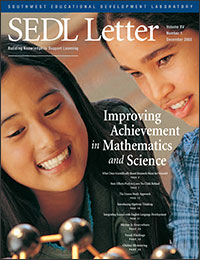Integrating Science with English Language Development
In a classroom where the students are predominately Hispanic, the teacher asks, “When you have a fever, what number does your mom tell you that the thermometer says?” Students call out numbers such as 38, 39, 40, 100, and 102. The teacher writes these numbers on an overhead projector. The students are puzzled by the numbers. How could they be so different? The teacher puts down a transparency of a thermometer and asked the students to look at the numbers. And they notice the 40 is about the same as 100. One student pipes up, “Oh, it’s bilingual like us.”
Since the early 1990s, we have been conducting research on promoting achievement and equity in science and literacy for culturally and linguistically diverse students in a large urban school district (Lee, 2002; Lee & Fradd, 1998). Currently, the research involves all teachers (more than 75) and their students (more than 2,000) from grades three through five at six elementary schools representing diverse languages and cultures, including Hispanic, Haitian, African- American, and Euro-American backgrounds.
As a study of natural phenomena in everyday life, science offers significant learning opportunities
The state in which the research is conducted implements instruction in English with ESOL students, without bilingual education. Subject-area instruction for ESOL students in their home languages is limited. At the elementary school level, the state mandates high-stakes statewide assessments in reading and mathematics from grades three through five and in writing at grade four. Statewide assessment in science is administered at the fifth-grade level as of the 2002–2003 school year, but it does not yet count toward school grades on which accountability is based.
Since science materials appropriate to the goal of our research were not readily available, we developed instructional units based on science standards documents (American Association for the Advancement of Science, 1989, 1993; National Research Council, 1996). These units include Measurement and Matter (grade 3), the Water Cycle and Weather (grade 4), and the Living Planet with a focus on the ecosystem and solar system (grade 5). Teachers participate in the revision and refinement of the units (Fradd, Lee, Sutman, & Saxton, 2002) and supplementary materials, as they offer insights about the linguistic and cultural experiences of diverse student groups, the appropriateness of the science content for elementary students, and the feasibility of implementation in elementary classrooms.
In our research, teachers attend full-day workshops on several regular school days over the course of a school year. Workshop activities are structured to encourage active involvement of all teachers—for example, by sharing questions and suggestions, and reflecting on their own beliefs and practices. Teachers also share insights about similarities and differences in the teaching and learning environments among the six schools. Initial workshops focus on familiarizing teachers with the purpose and objectives of the research and helping them gain experience in implementing specific activities and strategies with their students. Gradually, workshops involve helping teachers reflect on their own practices, assess the impact of their practices on student learning, and generate and sustain new ideas for effective practices.
We encourage principals and teachers to include English language learners (ELLs) in science instruction in their regular classrooms. Since the intervention is schoolwide and the emphasis on teaching science to ELLs is communicated to school personnel, ELLs are more likely to receive science instruction, be it in their regular classrooms or special ESOL programs. In addition, one school offers bilingual science instruction in self-contained ESOL classrooms including mostly entry-level ELLs. These students and their teachers participate in the project to an extent comparable with participation of the regular classrooms in their school.
Instruction takes place, on average, about two hours a week. Some teachers teach science as part of language arts or mathematics instruction. All teachers are provided with complete sets of materials, including teacher guides, student booklets, and science supplies (including trade books related to the science topics in the units). Despite a lull in science instruction from January through mid-March—related to preparation for the statewide assessments in reading, writing, and mathematics—most teachers complete instruction of their respective units by the end of the school year.
What Our Research Shows about Student Learning
Our research emphasizes promoting science inquiry and English language development simultaneously. To promote science inquiry with students who may be less familiar with scientific practices, instruction moves progressively along the continuum of teacher explicit instruction to student-initiated inquiry (Fradd & Lee, 1999). Within each instructional unit, earlier lessons are more structured, whereas later lessons are more open-ended to encourage student initiative and exploration. Later units are more complex than earlier ones in terms of both science concepts and the level of inquiry required of students.
Effective linguistic scaffolding by teachers is key to making school science accessible to English language learners.
The challenge of moving along the teacher explicit to student-exploratory continuum is further complicated for ELLs, who often must confront the demands of science learning through the vehicle of a language not yet mastered. Effective linguistic scaffolding by teachers is key to making school science accessible to ELLs, as teachers use language that matches students' levels of communicative competence in length, complexity, and abstraction, and ideally communicate at and slightly above students' level of communicative competence. Equally important is giving students structured opportunities to acquire the skills and concepts required for school science. By engaging in science inquiry with other students, ELLs develop not only their English grammar and vocabulary, but also their familiarity with the styles and genres of English appropriate to various science-related activities.
Students' science and literacy achievement is assessed using multiple instruments, including
- project-developed unit tests to measure students' knowledge of science concepts and inquiry;
- tests consisting of public-release items from the National Assessment of Educational Progress (NAEP) and the Third International Mathematics and Science Study (TIMSS),
- prompts for expository writing to measure students' levels of English proficiency and abilities to explain science concepts in writing; and
- elicitations with a small number of students as they design an experiment and write about the activity, as well as their work samples during classroom instruction.
The results indicate that students show significant improvements on all measures (Fradd et al., 2002). The elementary students in our research generally perform higher than their grade-level counterparts, and comparably or higher than middle school students, in the NAEP (national) and TIMSS (international) samples.
Below, writing samples of ELLs are presented. The water-cycle unit highlights the concept that simulations of the water cycle are models of the water cycle in nature; that the water cycle is a system with subsystems of evaporation, condensation, and precipitation; that heating and cooling cause patterns of change with water; and that the water cycle continues over and over.
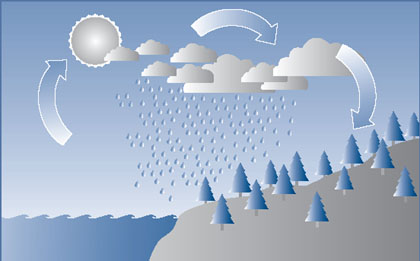
A fourth-grade ELL whose home language was Spanish wrote about the water-cycle simulation activity during elicitation sessions prior to and after instruction of the unit over a two-month period (see Writing Samples 1 and 2). The pre-instruction writing showed some understanding of the concept and an emerging level of English literacy, whereas the post-instruction writing showed a comprehensive understanding of the concept and a marked improvement in English literacy.
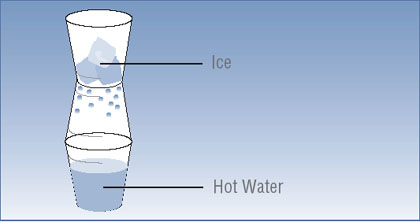
Writing Sample 1
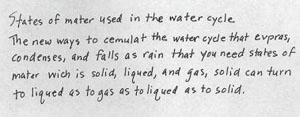
Writing Sample 2
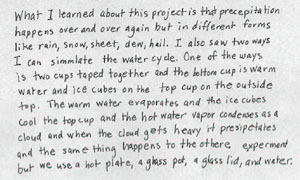
Building on the water-cycle unit, the lesson on wind in the weather unit also highlights the same big ideas that a simulation of wind (e.g., convection currents) is a model of wind in nature; that wind is a system that has subsystems of warm air rising and cool air falling; that heating and cooling cause patterns of change with air; and that the cycle continues over and over.
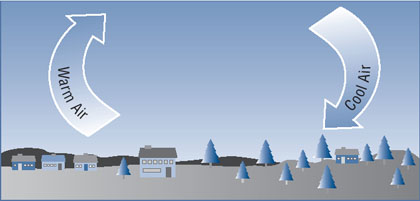
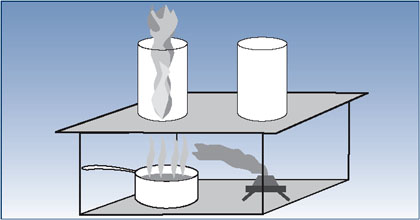
Warm and cold air
A fourth-grade ELL whose home language was Spanish and who had been in the United States for a short time wrote about the wind simulation activity in her workbook during class (see Writing Samples 3 and 4). Her writing showed a comprehensive understanding of the concept by accurately describing and explaining the activity through each step. The writing also showed literacy development—for example, she describes the sequence of events by using "Then" and "Finally" in the beginning of each new paragraph. The writing also showed improvement in spelling—she no longer writes, for example, "tub" for "tube," "stem" for "steam," and "combinate" for "combine." At the end of her writing, she wrote "no se lo permitio"—Spanish for "did not permit it."
Finally, a fourth grade ELL from Haiti summarized how the water cycle and wind simulations are similar and different during an elicitation session after instruction of both the water-cycle and weather units.
Writing Sample 3
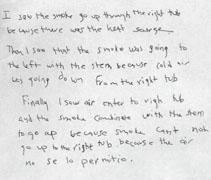
Writing Sample 4
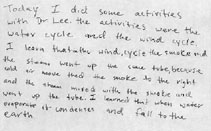
A Powerful Tool to Teach English and Language Literacy
As a study of natural phenomena in everyday life, science offers significant learning opportunities for all students. In particular, hands-on and inquiry-based science instruction provides opportunities for students to develop scientific understanding and engage in inquiry practices more actively than traditional textbook-based instruction. Science inquiry occurs when students generate questions, plan procedures, design and carry out investigations, analyze data, draw conclusions, and report findings. This type of instruction is especially promising for students from non-mainstream backgrounds, for a number of reasons:
- Hands-on activities are less dependent on formal mastery of the language of instruction and thus reduce the linguistic burden on ELLs;
- Collaborative, small-group work provides structured opportunities for developing English proficiency in the context of authentic communication about science knowledge;
- Hands-on activities based on natural phenomena are more accessible to students with limited science experience than decontextualized textbook knowledge; and
- Inquiry-based instruction provides an introduction to the scientific practices and discourse from which inner-city students are often excluded.
Summary
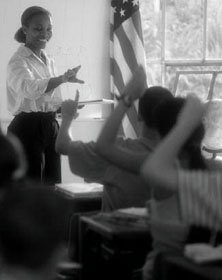 Although science instruction is often ignored for students from diverse languages and cultures, handson and inquiry-based science instruction can be a powerful tool to teach English language and literacy in the context of learning science. It is a challenge for educators to recognize both the linguistic and cultural resources ELLs bring to the learning process and the areas in which they need assistance. Teachers require professional development opportunities to develop deep and complex understandings of science and to learn pedagogical strategies in promoting English language and literacy as part of science instruction. Since educational policies for instruction and assessment in both science and ESOL/bilingual education influence classroom instruction, the support of school administrators is critically important. Eventually, ELLs understand science concepts, engage in science inquiry, and participate in science discourse, while also mastering English as a new language.
Although science instruction is often ignored for students from diverse languages and cultures, handson and inquiry-based science instruction can be a powerful tool to teach English language and literacy in the context of learning science. It is a challenge for educators to recognize both the linguistic and cultural resources ELLs bring to the learning process and the areas in which they need assistance. Teachers require professional development opportunities to develop deep and complex understandings of science and to learn pedagogical strategies in promoting English language and literacy as part of science instruction. Since educational policies for instruction and assessment in both science and ESOL/bilingual education influence classroom instruction, the support of school administrators is critically important. Eventually, ELLs understand science concepts, engage in science inquiry, and participate in science discourse, while also mastering English as a new language.
Instructional Strategies for Developing Literacy during Science Instruction
- Read a short story or a narrative vignette to activate students' prior knowledge on a science topic.
- Use specific comprehension questions about inquiry activities or science information in expository text.
- Use a variety of language functions (e.g., describing, explaining, reporting, drawing conclusions) in the context of science inquiry.
- Have students write an expository paragraph or narrative story describing the scientific process under investigation.
- Help students record data and report results in multiple formats (oral, written, and graphic).
- Help students create Venn diagrams or concept maps using vocabulary from the science lesson.
- Incorporate trade books or literature with scientific themes into instruction.
- Engage students in whole-group, small-group, or individual reading on science topics.
- Use writing tasks as homework assignment—for example, students can write about what they did in class, then share their writings with family members and write about what they talked about with family members, and share their writings in class.
References and Suggested Readings
- Amaral, O. M., Garrison, L., & Klentschy, M. (2002). Helping English learners increase achievement through inquiry-based science instruction. Bilingual Research Journal, 26(2), 213–239.
- American Association for the Advancement of Science. (1989). Science for all Americans. New York: Oxford University Press.
- American Association for the Advancement of Science. (1993). Benchmarks for science literacy. New York: Oxford University Press.
- August, D., & Hakuta, K. (Eds.). (1997). Improving schooling for language minority children: A research agenda. Washington, DC: National Academy Press.
- Casteel, C. P., & Isom, B. A. (1994). Reciprocal processes in science and literacy learning. The Reading Teacher, 47, 538–545.
- Fradd, S. H., & Lee, O. (1999). Teachers' roles in promoting science inquiry with students from diverse language backgrounds. Educational Researcher, 28(6), 4–20, 42.
- Fradd, S. H., Lee, O., Sutman, F. X., & Saxton, M. K. (2002). Materials development promoting science inquiry with English language learners: A case study. Bilingual Research Journal, 25(4), 479–501.
- Garc’a, E. E. (1999). Student cultural diversity: Understanding and meeting the challenge (2nd ed.). Boston: Houghton Mifflin Company.
- Hampton, E., & Rodriguez, R. (2001). Inquiry science in bilingual classrooms. Bilingual Research Journal, 25(4), 461–478.
- Hewson, P.W., Kahle, J. B., Scantlebury, K., & Davies, D. (2001). Equitable science education in urban middle schools: Do reform efforts make a difference? Journal of Research in Science Teaching, 38(10), 1130–1144.
- Lee, O. (2002). Science inquiry for elementary students from diverse backgrounds. In W. G. Secada (Ed.), Review of research in education, Vol. 26 (pp. 23–69).Washington, DC: American Educational Research Association.
- Lee, O., & Fradd, S. H. (1996). Literacy skills in science performance among culturally and linguistically diverse students. Science Education, 80(6), 651–671.
- Lee, O., & Fradd, S. H. (1998). Science for all, including students from non-English language backgrounds. Educational Researcher, 27(3), 12–21.
- National Center for Education Statistics. (1999). Teacher quality: A report on the preparation and qualifications of public school teachers. Washington, DC: U. S. Department of Education, Office of Educational Research and Improvement.
- National Research Council. (1996). National science education standards. Washington, DC: National Academy Press.
- Spillane, J. P., Diamond, J. B.,Walker, L. J., Halverson, R., & Jita, L. (2001). Urban school leadership for elementary science instruction: Identifying and activating resources in an undervalued school subject. Journal of Research in Science Teaching, 38(8), 918–940.
- Stoddart, T., Pinal, A., Latzke, M., & Canaday, D. (2002). Integrating inquiry science and language development for English language learners. Journal of Research in Science Teaching, 39(8), 664–687.
Promoting English Language Development with English Language Learners
In addition to developing general literacy with all students, teachers can provide explicit guidance to promote ELLs' English language development (Amaral, Garrison, & Klentschy, 2002; Hampton & Rodriguez, 2001; Stoddart, Pinal, Latzke, & Canaday, 2002) by using these strategies:
- Recognize the diversity of students' levels of language proficiency and adjust the language load required for their participation.
- Use multiple modes of communication and representation (verbal, gestural, written, graphic) to enhance students' understanding of science.
- Introduce key vocabulary in the beginning and encourage students to practice the vocabulary in a variety of contexts to enhance their understanding.
- Promote precision in describing and explaining objects and events—for example, give explicit attention to particular words, such as positional words (e.g., above, below, inside, outside), comparative terms (e.g., cold, colder, coldest), and affixes (e.g., /in-/ in "increase" or "inflate" as opposed to /de-/ in "decrease" or "deflate").
- Promote meaningful engagement and authentic communication through the use of narrative vignettes or expository texts related to everyday experiences.
- Use various group formations, so that students learn to work independently as well as collaboratively.
Okhee Lee is a professor and Mary Avalos is a research assistant professor in the Department of Teaching and Learning at the University of Miami, Coral Gables, Florida.
Next Article: Matter is Everywhere | Hay materia en todos lados
